The building was not, evidently, richly
built and decorated, and there is discussion whether it was ever
properly completed -- a fact which may be explained by its construction in
the
troubled fourth century. If, for example, it was built by "Donatists" in
the years after Julian's rehabilitation of them (362ff), it is plausible
that a further reversal in imperial policy may have made it difficult to
proceed. (See Marrou's article cited above.) Moreover, if we did not
have such
an interest in Augustine, then we would give more attention than most do
to the quite interesting history of this basilica in Vandal times (roughly
430-534), for there is an interesting series of tombs dating from that
period, making it the best known -- from the material remains -- part of
this building's history.
The apse of the basilica featured a bench running
the length of the semicircular back wall,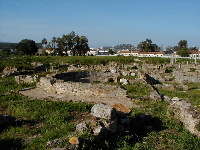 on which the clergy sat for appropriate portions of the service:
that bench remains almost entirely intact, and so perhaps the closest one
can come to Augustine physically is to align gluteal muscles in the same
physical space that his once occupied. To read a few lines of the
Confessions there, a matter of a few yards from the spot where they
will
have been conceived and written, seems perfectly appropriate, though perhaps
the lines chosen should be the same ones Petrarch read on Mount Ventoux.
(For a description of the eucharistic ritual at Hippo, click here.)
on which the clergy sat for appropriate portions of the service:
that bench remains almost entirely intact, and so perhaps the closest one
can come to Augustine physically is to align gluteal muscles in the same
physical space that his once occupied. To read a few lines of the
Confessions there, a matter of a few yards from the spot where they
will
have been conceived and written, seems perfectly appropriate, though perhaps
the lines chosen should be the same ones Petrarch read on Mount Ventoux.
(For a description of the eucharistic ritual at Hippo, click here.)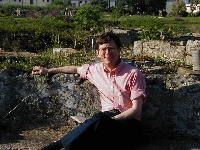
A few yards beyond the basilica from the forum,
one finds the remains of the small baptistry. The font itself is
shallower than we expected (though bear in mind that both testers pictured
here are beef-eating modern six-footers), and clearly large enough only
for a single candidate at a time to join the bishop or deacon. For a description
of that ritual, click here.
The surviving columns presumably supported curtains for privacy at the
decisive moment.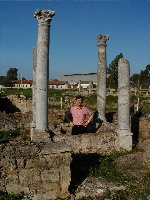
Beyond the church buildings again, the archaeologists
have found remains of fine houses, discovery bearing out what Augustine
tells us of the property of the wealthy Julianus that lay next to his church
(ep. 99.1).
A short, sharp climb up the adjacent hillside
(which some think to have been the site of the ancient citadel of the
city) leads to a museum housed in what we were assured is an old
penitentiary.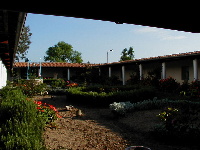 The courtyard building has a functioning well in its center, a presiding
cat (who seemed particularly responsible for the small library), and three
exhibit rooms. Two of the rooms house quite remarkable mosaics, samples
of which I photographed here -- mosaics of the
good life of Roman Africa, markers of the prosperity that good and productive
farmland adjacent to a safe harbor could mean.
I used to compare Hippo, for my students, with the American cities of Fall
River and New Bedford MA -- port cities of some prosperity but little cultural
charm, cities from which the cultivated resident would often flee to Boston.
That flight to the cultured metropolis remains an appeal from Hippo, but
perhaps one should think rather of Omaha or Des Moines -- capital cities
of rich farmlands, proud centers of accomplishment and (absent the threats
of drought and war) assured prosperity.
The courtyard building has a functioning well in its center, a presiding
cat (who seemed particularly responsible for the small library), and three
exhibit rooms. Two of the rooms house quite remarkable mosaics, samples
of which I photographed here -- mosaics of the
good life of Roman Africa, markers of the prosperity that good and productive
farmland adjacent to a safe harbor could mean.
I used to compare Hippo, for my students, with the American cities of Fall
River and New Bedford MA -- port cities of some prosperity but little cultural
charm, cities from which the cultivated resident would often flee to Boston.
That flight to the cultured metropolis remains an appeal from Hippo, but
perhaps one should think rather of Omaha or Des Moines -- capital cities
of rich farmlands, proud centers of accomplishment and (absent the threats
of drought and war) assured prosperity. 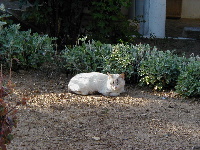
The modern basilica is of less interest to students
of Augustine but of no small interest to the history of French colonialism
and modern Catholicism. Inter alia, it houses what is soberly presented as Augustine's elbow.
The story has it that Augustine's remains were removed from Africa either
in the time of the Vandals (430-534) or in the face of the Islamic invasions
(taking Carthage in 698) to Sardinia, and thence removed again to Pavia,
where they lie today in the same church as the remains of Boethius.
Whatever the truth of that story, it was French colonialism and French
Catholicism together than made representations in the nineteenth century
that it was only appropriate that some piece of Augustine's remains return
to Hippo. Thus in 1842, an elaborate ecclesiastical pilgrimage from
Pavia to Bône (as Hippo/Annaba was then known) brought Augustine's
elbow. (The
traveling reliquary from that translation was on display in the lobby
of Annaba's theater in a small exhibit during our visit.) The elbow
has now been inserted for veneration in the anatomically appropriate spot
in a large carved figure of the saint, recumbent behind the main altar
of the basilica.
Inter alia, it houses what is soberly presented as Augustine's elbow.
The story has it that Augustine's remains were removed from Africa either
in the time of the Vandals (430-534) or in the face of the Islamic invasions
(taking Carthage in 698) to Sardinia, and thence removed again to Pavia,
where they lie today in the same church as the remains of Boethius.
Whatever the truth of that story, it was French colonialism and French
Catholicism together than made representations in the nineteenth century
that it was only appropriate that some piece of Augustine's remains return
to Hippo. Thus in 1842, an elaborate ecclesiastical pilgrimage from
Pavia to Bône (as Hippo/Annaba was then known) brought Augustine's
elbow. (The
traveling reliquary from that translation was on display in the lobby
of Annaba's theater in a small exhibit during our visit.) The elbow
has now been inserted for veneration in the anatomically appropriate spot
in a large carved figure of the saint, recumbent behind the main altar
of the basilica.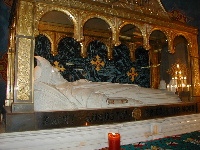 The church is served to this day by Augustinian priests (the archbishop
of Algiers, we were told, numbers about 10,000 catholics in his flock and
comes himself from metropolitan France). Plaques on the side
walls of the basilica memorialize various benefactors, including a number
of Americans and, in at least one case an entire American military unit
from World War II. (One apology will stand for all here: we
traveling Augustine scholars were acutely aware how ill-informed we were
about much local history. On return to the US, I find that the theatre,
for example, is a 1940s reconstruction after bombing that destroyed the
nineteenth century house on the same site.)
The church is served to this day by Augustinian priests (the archbishop
of Algiers, we were told, numbers about 10,000 catholics in his flock and
comes himself from metropolitan France). Plaques on the side
walls of the basilica memorialize various benefactors, including a number
of Americans and, in at least one case an entire American military unit
from World War II. (One apology will stand for all here: we
traveling Augustine scholars were acutely aware how ill-informed we were
about much local history. On return to the US, I find that the theatre,
for example, is a 1940s reconstruction after bombing that destroyed the
nineteenth century house on the same site.)
The time spent in ancient Hippo was remarkable
for the company we kept. Most visitors for the conference knew most
of the others by name at least, many by more direct relationship, but still
mainly at a distance. But we had all spent years of our lives working
on and thinking about what this man Augustine left behind. So we
found ourselves, rather to our own surprise, in this place of his -- given
the difficulties of the trip, many of us I think had never expected to
get here -- seeing a place we had never seen but about which we knew a
great deal. And so you would find yourself at one point or another
among the remains standing next to someone you barely knew, and conversation
would ignite about the finer points of the scene -- both of you knowing
what the other would know and initiating a conversation as though it were
one that had gone on for years, even if the two of you had in fact never
met before. This sense of extraordinary conversational opportunity
continued through the trip -- I think particularly of an hour's seminar
on Augustine's family and home that ran back and forth in the front row
of seats on one of the busses going up to Mdaourouch, a seminar from which
I learned more than I usually learn in formal meeting rooms.
Our visit to the site of Hippo Regius lasted about
three hours and ended as sunset began to take the light from us.
But a fair description of ancient Hippo requires at least some mention
of what we learned the next day on our bus ride south to Souk Ahras and
Mdaourouch.
Augustine's responsibility as bishop of Hippo
extended over the churches of the surrounding countryside as well.
As we drove south out of Hippo, it was easy to think about the many small
communities that dotted that plain then and now. (One through which
we drove was the birthplace of Albert Camus, whose father worked for a
vintner in those parts.) Hippo was prosperous because of that plain
and isolated because of the mountains surrounding it. A coastal road
was picked out to Carthage even in antiquity, but it was not one of the
major roman routes -- it was a fairly difficult road and for rapid travel
along the coast, boats were more efficient. Somewhere on that plain
was Fussala, the castellum to which Augustine ordained the young man Antoninus
as bishop in 411, a mistake he spent the rest of his career regretting.
But then the mountains start. As we progressed,
we began discussing just how badly Augustine must have wanted to make a
convert in Hippo in 391 to bring him from his family home in Tagaste all
the way down to the coast. Though the distance is about 60 miles,
the climb up whether for man or donkey-riding man would be an appreciable
and slow ascent, a matter of several days at best (with what rests along
the way?). Additional images of
Annaba/Hippo.
Tagaste.
Augustine's birthplace had the least to offer our visit. Characterized
by Peter Brown as one of those "nuclei of egregious self-respect" that
marked the landscape of Roman Africa, the town was a minor municipality
in Augustine's time, its grandees (like Romanianus), minor grandees.
The town sits on a ridge above the fairly deep valley of the upper Medjerda
river, along whose course (more or less) the main east-west road of Roman
Africa ran, linking Carthage to the Cirta/Constantine and the provinces
beyond along the coast. (About halfway from Carthage to Tagaste,
a fork in the road trended south to the high plains of Numidia, taking
travelers to Theveste/Tebessa, Timgad, and Lambaesis.) Numerous
inscriptions in ancient Libyan and neo-Punic have been found in the
area. Today the
town surprised ignorant westerners by its size, urban character, and prosperity.
The valley of the Medjerda remains relatively lush and fertile (as in this
panoramic view of Tagaste countryside [large and slow to load, taken
from a book we were given at the conference]), and the grain elevators
remained a feature of the landscape. We passed through Tagaste briefly
on our way south to Mdaourouch, then returned in the afternoon for a brief
stay. We had been cautioned in a lively address by Mme. Nacera Benseddik
during conference proceedings in Hippo not to expect archaeological remains:
what opportunity there was for significant work may now have been lost
to urbanization. Instead, we stopped briefly to pay homage to an
olive tree.
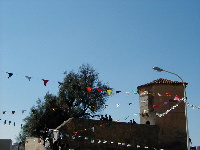 The
site is behind a school on a hilltop in the middle of Souk Ahras.
We debussed on narrow streets and entered an open courtyard where a variety
of ancient inscriptions and moderate pieces of stonework were on display,
then ascended an open staircase to a smaller outcropping where the olive
tree in question was on display. This, we were assured, was the selfsame
olive under which the young Augustine would sit to meditate. We had
heard in Algiers a fascinating paper (see above) on the early modern memory
of Augustine in the Maghreb, and my inclination would be to think that
this olive tree represents something of that same phase of memory and interpretation.
The olive tree is more "natural" to this locality and suitable for
memorialization,
but its identification and veneration seems to draw a little from the fig
tree of Milan (by which Augustine threw himself down to hear the heavenly
voice encouraging him to "take up and read") and the Eden-evoking pear
tree of Tagaste that marked Augustine's fall into carnal sin in book 2
of the Confessions. (It had been our intention to scour the Tagastan
countryside for any signs of a pear tree to photograph, perhaps even from
which to filch a few half-ripened pears, but the intense urban buildup
and the strict control of our movements rendered this unfortunately impossible.)
The
site is behind a school on a hilltop in the middle of Souk Ahras.
We debussed on narrow streets and entered an open courtyard where a variety
of ancient inscriptions and moderate pieces of stonework were on display,
then ascended an open staircase to a smaller outcropping where the olive
tree in question was on display. This, we were assured, was the selfsame
olive under which the young Augustine would sit to meditate. We had
heard in Algiers a fascinating paper (see above) on the early modern memory
of Augustine in the Maghreb, and my inclination would be to think that
this olive tree represents something of that same phase of memory and interpretation.
The olive tree is more "natural" to this locality and suitable for
memorialization,
but its identification and veneration seems to draw a little from the fig
tree of Milan (by which Augustine threw himself down to hear the heavenly
voice encouraging him to "take up and read") and the Eden-evoking pear
tree of Tagaste that marked Augustine's fall into carnal sin in book 2
of the Confessions. (It had been our intention to scour the Tagastan
countryside for any signs of a pear tree to photograph, perhaps even from
which to filch a few half-ripened pears, but the intense urban buildup
and the strict control of our movements rendered this unfortunately impossible.)
From our visit to the tree, we were bussed again
to the Wilaya (roughly: town hall) of Tagaste, where crowds of local
residents filled the streets to see our coming and going. Here in
a large hall we found refreshments, an exhibit of Augustiniana, and hostesses
attired in a variety of forms of -- of all things -- bridal dress, eastern
and western.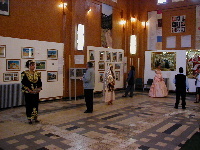 A brief welcoming ceremony was held in which conference speakers were each
recognized by name and given a souvenir plaque with the city's coat of
arms (Latin slightly misspelled) -- they are now honorary citizens and
have certain tax immunities in consequence, and then after an hour we
filed out through
the waiting crowds and were bussed away. It was a moderately surreal
experience, inasmuch as a visit to an exhibit of Augustiniana by scholars
rarely brings out crowds elsewhere; but we were all conscious as well that
we were too ready to take the exhibit for granted. But for the Islamic
authorities of an Algerian town to devote their public space to the memorials
of a Christian saint -- even a local boy made good -- surely took courage
and determination. Our presence was thus meant to validate the breadth
of vision implicit in making the exhibition at all. In a country
that has seen too many martyrs of every stripe from antiquity to the present
day, it was easy both to admire the intent and to wonder what will become
of it.
A brief welcoming ceremony was held in which conference speakers were each
recognized by name and given a souvenir plaque with the city's coat of
arms (Latin slightly misspelled) -- they are now honorary citizens and
have certain tax immunities in consequence, and then after an hour we
filed out through
the waiting crowds and were bussed away. It was a moderately surreal
experience, inasmuch as a visit to an exhibit of Augustiniana by scholars
rarely brings out crowds elsewhere; but we were all conscious as well that
we were too ready to take the exhibit for granted. But for the Islamic
authorities of an Algerian town to devote their public space to the memorials
of a Christian saint -- even a local boy made good -- surely took courage
and determination. Our presence was thus meant to validate the breadth
of vision implicit in making the exhibition at all. In a country
that has seen too many martyrs of every stripe from antiquity to the present
day, it was easy both to admire the intent and to wonder what will become
of it. Additional images from
our
visit to Souk Ahras
Madauros.
Augustine was a child of no more than about 14, perhaps younger,
when he was sent away from home (with a servant or two for guidance,
protection, and
support?) to live in Madauros and pursue his education. Claude Lepelley
(another of our conferees) wrote once of how Augustine's story can be read
as a Balzacian family novel "avant la lettre", in which Augustine's family
sought to acquire at great cost (money and chutzpah -- conf. 2.3.5,
'animositate')
an education for their most talented son (it's not clear whether Augustine
was older than his brother Navigius, but quite clear that Navigius was
always meant for obscurity), an education that would lead him to a career
by which the whole family would profit. So it was that when his career
began to show signs of significant payoff, with his appointment to the
imperial chair of rhetoric in Milan, his family showed up en bloc (mother,
brother, cousins) to see what opportunities for advancement Augustine's
own career would offer them.
We do not know why Madauros was chosen, but though
small and set off from the beaten track, it had a history of cultural achievement.
The career of Apuleius,
surely Madauros' most famous progeny, had marked that achievement two hundred
years before Augustine's time, and we have an exchange of letters between
Augustine and one of the most cultured men in Madauros (Aug. epp.
15-16)
that captures for us something of the pride in heritage that animated the
learned citizens of the town.
Madauros lies about 15 miles further south
of Tagaste (altitude, 800 meters above sea level), and Augustine and his
little entourage could have made the
trip in a day, sometime around 360 CE. But the boy must have been
as surprised as we were, whenever he first made that trip, at the change
in the landscape. From Hippo you ascend the mountains of the Medjerda
towards Tagaste, then subside again into the valley. The valley is
steep enough that the town of Tagaste stayed up from the valley bottom
on the north side, so you descend first from Tagaste further, then rise
again on the other side. But this time as you come to the top of
the valley, you find that you are not ascending a mountain, but rather
climbing to the high plain. There is a moment when you come up over
a ridge, past farmhouses of a kind you've been passing since you left the
coast, and over that ridge the land suddenly opens up into a wide spreading
plain of grassland under a great dome of blue sky.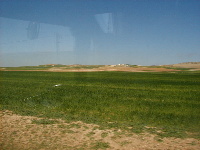 For an old westerner long accustomed to the claustrophobic landscapes of
the American east, I felt an immediate sense of relief and exaltation.
The horizon had fled, the sky had enlarged, and the land lay before us
still green and inviting. To be sure, that ridge marks a rainfall
line and up on the plains annual rainfalls are a fraction what they are
in the Medjerda valley and down to the coast, but it is still far from
desert -- the real African desert begins another hundred miles and more
farther south. The wheat fields are now behind us, but this is the
land that grew astonishingly prosperous in the third and fourth centuries
CE for the growing of olives. When Augustine went away to Italy,
there is a piece of one of his first dialogues that captures the prosperity
of Africa in its absence: through the long winter nights in Italy,
they lie awake sometimes talking, but using no light, because oil for lamps
is expensive. In Africa, it was abundant and cheap, but a valued
export. At the heart of the archaeological site of Madauros we came
upon the olive press and its associated buildings, surely a significant
piece of the prosperity of that town for many years.
For an old westerner long accustomed to the claustrophobic landscapes of
the American east, I felt an immediate sense of relief and exaltation.
The horizon had fled, the sky had enlarged, and the land lay before us
still green and inviting. To be sure, that ridge marks a rainfall
line and up on the plains annual rainfalls are a fraction what they are
in the Medjerda valley and down to the coast, but it is still far from
desert -- the real African desert begins another hundred miles and more
farther south. The wheat fields are now behind us, but this is the
land that grew astonishingly prosperous in the third and fourth centuries
CE for the growing of olives. When Augustine went away to Italy,
there is a piece of one of his first dialogues that captures the prosperity
of Africa in its absence: through the long winter nights in Italy,
they lie awake sometimes talking, but using no light, because oil for lamps
is expensive. In Africa, it was abundant and cheap, but a valued
export. At the heart of the archaeological site of Madauros we came
upon the olive press and its associated buildings, surely a significant
piece of the prosperity of that town for many years. Additional images of Algerian landscapes.
At all events, the several hours we spent at Madauros
were all played out under this sky and against these horizons, and the
photos of buildings and people that follow are most of them marked as well
by at least some glimpse of the setting. We had fine weather throughout
our visit, temperatures around 60°F -- more humid in Algiers, pleasanter
in Annaba, and extraordinarilyy dry and fresh in the highlands. There
must be days that are less pleasant, but if we learned nothing else on
this trip so vividly, it was that Augustine's world was one that could
delight the senses in many ways.
We approached Madauros in a roundabout way.
The road from Tagaste branches before you reach the town of Mdaourouch and
the left fork would take you directly to the ancient site, but we followed
the right fork. This took us into the town of Mdaourouch, much smaller
than Souk Ahras, perhaps a few thousand residents only, where our busses
filed through streets thronged with curious residents and past at least
one billboard with the painted faces of half a dozen martyrs in distinctive
Islamic dress. The crowd on the streets was almost entirely male
-- we noticed one woman, but she was right by the railroad station and
may have found herself there for other reasons. Crossing the
tracks, our route doubled back and out of the town 1-2 miles up onto a
slightly more elevated part of the plain towards the ancient city.
We pulled up at a point where what we could see where a few modern tents
pitched and cars parked by the side of the road, and debussed.
The first sight was a welcoming archway run up
for the occasion with foliage and two national flags. We walked through
this with the lack of selfassurance with which moderns perform ceremonial
gestures, and found a welcoming party waiting for us with bullhorn, speeches,
and costumes. What we also saw beyond the welcomers was more surprising:
first a row of robed musicians aligned along the road, eight or so horsemen
in costumes of Ottoman times -- extras from "Lawrence of Arabia", with
sabers and old breech-loading shotguns.
Beyond them, a second costumed musical group, again with percussion instruments
of various kinds. As we walked forwards, the musicians played and
danced, and then the riders took turns welcoming us with shotgun blasts
into the air -- startling at first, then festive. The bandsmen would
be with us throughout our visit, but while the visitors explored the ruins,
the horsemen adjourned below to an open field between ancient and modern
towns. There in the course of the mid-day we could see them, most
of a mile off, performing impromptu horseback races to a large and appreciative
crowd -- we would hear a gunshot and look up from ancient stones to see
two riders scampering on quarter horses a few hundred yards or so to victory
or defeat.
For the crowds were large and appreciative.
Perhaps 1500-2000 people had come out for the day, mostly but not exclusively
young people, walking out from the town to observe the goings-on.
All our touring of the ancient site and the festivities that followed were
played out with this crowd held back a hundred yards or so from the perimeter.
(Beyond the ancient site lay open countryside, with only the sight of a
few distant policemen at intervals along the ridge to separate us from
the long reaches of vision towards the south.) When the open-air
banquet was ending, the security forces relaxed the perimeter and a sudden
stampede brought our spectators to within a few feet, and the more venturesome
boys would then infiltrate our crowd, to see the Europeans and Americans
more closely, or to filch a couple of apples from the bowls on our tables.
Their curiosity was palpable, but they were at the same time very timid
and shy, whether or us or of the security officers who would occasionally
chase one or two away, it was hard to say.
The ancient remains of Madauros have been excavated
and preserved with clarity and are a joy to visit. Two later buildings
-- Byzantine in date-- have overbuilt parts of the site, but not in a way
that materially reduces access to the ancient remains. In particular,
a small Byzantine fortress (dated 535, that is to the reign of Justinian,
by the "Guide Bleu") was built on and around the ancient
"theater" (Prof. Dorothea Weber -- seen
here on the site with Professors Serge Lancel and Konrad Vössing
-- observed that this space marked as such could not have indeed been a
theater but was more likely an odeon, hence very probably a place
in which the young Augustine would at least have heard rhetorical and poetic
performances and perhaps delivered them himself) -- the same conversion
of place of spectacle to place of defense occurs elsewhere, as at Bosra
in Syria, where a very large theatre now lurks unsuspected inside a dark
and forbidding fortress. The chief sights are the ancient baths (in
best state of preservation), the oil press, two churches (now mere outlines
of foundation stones in the grass), and the forum/odeon complex inside
the fortress. Given the lay of the land and the way we approached,
most of the visitors wound up gravitating to this last site, not least
because it offered views back over the crowds of spectators, the horse
races, and the town of Mdaourouch.
(Prof. Dorothea Weber -- seen
here on the site with Professors Serge Lancel and Konrad Vössing
-- observed that this space marked as such could not have indeed been a
theater but was more likely an odeon, hence very probably a place
in which the young Augustine would at least have heard rhetorical and poetic
performances and perhaps delivered them himself) -- the same conversion
of place of spectacle to place of defense occurs elsewhere, as at Bosra
in Syria, where a very large theatre now lurks unsuspected inside a dark
and forbidding fortress. The chief sights are the ancient baths (in
best state of preservation), the oil press, two churches (now mere outlines
of foundation stones in the grass), and the forum/odeon complex inside
the fortress. Given the lay of the land and the way we approached,
most of the visitors wound up gravitating to this last site, not least
because it offered views back over the crowds of spectators, the horse
races, and the town of Mdaourouch. Additional images from our visit to the
archaeological site
After a couple of hours' exploration, our
hosts
began discreetly urging us to move towards the low tents that we had passed
on entering the site. There we found that we were to be guests for
a traditional banquet al fresco. Ottoman sofas for some of us, plastic
chairs for others, piles of cushions for others (who found their agility
and aptitude for decorum challenged). An array of costumed servers
and hostesses stood by each tent, though the polyester in the fabrics and
some aspects of the footgear suggested that this was a spectacle rather
than a naively authentic native ritual.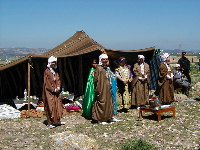
The food was the best we had in Algeria -- a fresh
salad, a soup, then roast lamb -- in this case dozens of whole lambs on
the gridiron, roasted in the open air, each one brought to a separate
table
outside our tents. We were encouraged to come forth and attack the
lambs. Literally: there was for a few minutes the spectacle
of dozens of sober European and American scholars tearing roasted lamb
carcasses to bits and devouring the results. The sight did
not lend itself well to photography, not least because the many visiting
photographers had at that moment fingers covered with fat and grease, but
I am told at least one distinguished scholar has been recorded in a
carnivorous and unpublished moment.
Paper napkins sufficed for most, but silver vessels, pitchers, and soap
were available for a more traditional ablution afterwards.
Couscous slathered with honey made the next course,
followed by the bowls of fruit (oranges, apples, and huge and succulent
dates) that were dessert for us throughout our stay in Africa.
At this point, the musical groups that had greeted
us began to filter into the space among the tents. The rather more
polished and westernized group (I'm not sure why I had that impression)
began first, and were quickly joined by dancers male and female from amid
the customed staff, and then a few of the more venturesome members of the
visiting community joined as well. The effect was striking and the enthusiasm of musicians and dancers quite
evident. Given that we had no program of events, it all had a quite
spontaneous and exhilarating air about it that must have taken a great
deal of planning to arrange. The second band, whose members were
older and less histrionic perhaps, shortly joined in with a performance
of their own. It was about this time that the outer perimeter keeping
the crowds back was dropped and the area around the tents became crowded
and convivial. Much of the film shot that day was used in that last
half hour.
The effect was striking and the enthusiasm of musicians and dancers quite
evident. Given that we had no program of events, it all had a quite
spontaneous and exhilarating air about it that must have taken a great
deal of planning to arrange. The second band, whose members were
older and less histrionic perhaps, shortly joined in with a performance
of their own. It was about this time that the outer perimeter keeping
the crowds back was dropped and the area around the tents became crowded
and convivial. Much of the film shot that day was used in that last
half hour. Additional images
from
the festivities.
Eventually we were herded back to our busses.
This time we left by the direct route, going away from the ancient city
without revisiting the modern town, and we made our way back to Tagaste/Souk
Ahras for the visits described above.
Guelma, et al.: On April
7, the group left the Hotel Seybouse in Annaba, bound for the town of Guelma,
the Roman town of Calama, where Augustine's colleague and biographer, Possidius,
had been bishop. At mid-morning, we were greeted by what had become
the customary gathering of local dignatries and by the local Scouts, boys
and girls alike in their blue uniforms. After words of welcome, we
were treated to a snack consisting of pastries, soft-drinks, milk (for
the first time) and fruit. Small cups of strong coffee were available
for the hardy.
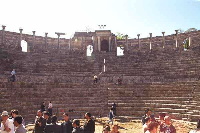 Calama
had a theatre and Guelma has gone to some efforts to restore it. We entered
through the rear of the stage and were struck by the condition of the building,
which is in better repair than the smaller theatre which we had seen at
Madura on the day previous. The stage is covered with a wooden floor,
with appropriate statues in place along its back wall. The seating has
been well restored and the wall behind is now complete.
Calama
had a theatre and Guelma has gone to some efforts to restore it. We entered
through the rear of the stage and were struck by the condition of the building,
which is in better repair than the smaller theatre which we had seen at
Madura on the day previous. The stage is covered with a wooden floor,
with appropriate statues in place along its back wall. The seating has
been well restored and the wall behind is now complete.
Two small rooms, just off the choir area in front
of the stage, now house an extensive collection of grave stele, each about
half a meter tall. They range in time from the Lybian through the Roman
period and attest to the richness of the pre-roman remains in this part
of Algeria. Two additional museum rooms were accessible to the right
and left of the stage itself. These exhibited statues and decorated
columns which had been found on the site.
The center of the town is an open-air archeological
park in which various forms of ancient objects, all in stone, are displayed
amid new plantings. Most were funerary objects of one sort or another,
ranging from stele dedicated to Tanit and inscribed in ancient Lybian letters,
to Christian monuments. Among the latter was a funeral mensa marked
with a Christogram incised, evidence of the Christian practice of feasting
with the dead, either the martyrs or the family ancestors or perhaps the
revision of family history after conversion to Christianity, since in both
cases the christogram is clearly added to an existing inscription.
Augustine had worked against this practice, suggesting that the deceased
would be helped more by the giving of the food to the poor rather than
offering it to the dead, who could certainly not enjoy it.
Program
of a current conference on the virtual university and the virtual library
at the University of Guelma
After leaving Guelma, we made a detour to the
Roman city of Thibilis, beautifully situated in a valley. The welcoming
delegation included a greater range of people, as we were greeted not only
by administrators but by local farmers, and the ubiquitous scouts.
This time, we each had the opportunity to shake every hand. These
Algerian men have a striking custom of touching their right hands to their
hearts before greeting each of the visitors coming down the receiving line.
The site itself showed signs of having been cleaned
especially for our visit and we were restricted to a small part of it.
A Byzantine church on the hillside facing the main gate overlooked the
town; the ruins of its facade provides a good view of the whole.
The paving of the modest forum remains intact and the footings of the temples
are still in place. We did not have the opportunity to visit the
ruins of the pre-byzantine church, which we were later told has a baptistry
still in place.
The final archeological stop in eastern Algeria
was a Roman piscina or swimming pool, some thirty meters in diameter and
about one and one-half meters deep. The wall was formed in stone,
with a gently sloping concrete bottom. Stairs were set into the wall and
the water channel for filling the pool was still evident. Water was
being pumped into the pool at the time of our arrival (and our departure).
If the structure is still in use, it had clearly stood empty through the
winter months. We were again treated to a welcoming repast, complete this
time with a kind of curdled milk which tasted like the beginnings of cheese.
Scouts were everywhere in evidence, with one group singing throughout the
visit. Additional images from the final
day's
visits.
Back into the buses and we were off to a fairwell
luncheon as guest of the Wali of Annaba. During the meal, we were
entertained by a musical group which differed significantly from those
we had enjoyed at Madura on the prior day. This ensemble of some
dozen men played a great variety of stringed instruments, both bowed and
plucked, in addition to the drums and flutes we had heard before. Some
of the pieces were sung by one or more of the players.
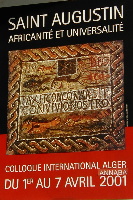 Three days of the week were devoted to site visits in eastern Algeria.
I was only able to participate in the first two days, but Professor Patout
Burns has been kind enough to supply an account of the third. The
agenda took us on the first day to Annaba, site of ancient Hippo Regius,
Augustine's episcopal see and place of residence from 391-430. The
second day took us 75 miles up country to Mdaourouch (ancient Madauros),
where Augustine attended grammar school (and, incidentally, where Apuleius
was born), and to Souk Ahras (ancient Tagaste), where Augustine was born
and raised. Tagaste's archaeological remains have never been excavated
and have indeed probably been destructively overbuilt, but Madauros survives
because the present-day community is built at about at two-mile distance
from the ancient site, which is quite isolated and unspoiled. On
the third day, the group visited Guelma (ancient Calama), site of the bishopric
of Augustine's friend and biographer Possidius and site of substantial
and interesting archaeological remains.
Three days of the week were devoted to site visits in eastern Algeria.
I was only able to participate in the first two days, but Professor Patout
Burns has been kind enough to supply an account of the third. The
agenda took us on the first day to Annaba, site of ancient Hippo Regius,
Augustine's episcopal see and place of residence from 391-430. The
second day took us 75 miles up country to Mdaourouch (ancient Madauros),
where Augustine attended grammar school (and, incidentally, where Apuleius
was born), and to Souk Ahras (ancient Tagaste), where Augustine was born
and raised. Tagaste's archaeological remains have never been excavated
and have indeed probably been destructively overbuilt, but Madauros survives
because the present-day community is built at about at two-mile distance
from the ancient site, which is quite isolated and unspoiled. On
the third day, the group visited Guelma (ancient Calama), site of the bishopric
of Augustine's friend and biographer Possidius and site of substantial
and interesting archaeological remains.

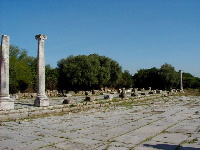
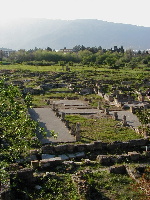
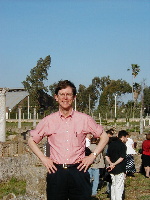



 The courtyard building has a functioning well in its center, a presiding
cat (who seemed particularly responsible for the small library), and three
exhibit rooms. Two of the rooms house quite remarkable mosaics, samples
of which I photographed
The courtyard building has a functioning well in its center, a presiding
cat (who seemed particularly responsible for the small library), and three
exhibit rooms. Two of the rooms house quite remarkable mosaics, samples
of which I photographed


 The
site is behind a school on a hilltop in the middle of Souk Ahras.
We debussed on narrow streets and entered an open courtyard where a variety
of ancient inscriptions and moderate pieces of stonework were on display,
then ascended an open staircase to a smaller outcropping where the olive
tree in question was on display. This, we were assured, was the selfsame
olive under which the young Augustine would sit to meditate. We had
heard in Algiers a fascinating paper (see above) on the early modern memory
of Augustine in the Maghreb, and my inclination would be to think that
this olive tree represents something of that same phase of memory and interpretation.
The olive tree is more "natural" to this locality and suitable for
memorialization,
but its identification and veneration seems to draw a little from the fig
tree of Milan (by which Augustine threw himself down to hear the heavenly
voice encouraging him to "take up and read") and the Eden-evoking pear
tree of Tagaste that marked Augustine's fall into carnal sin in book 2
of the Confessions. (It had been our intention to scour the Tagastan
countryside for any signs of a pear tree to photograph, perhaps even from
which to filch a few half-ripened pears, but the intense urban buildup
and the strict control of our movements rendered this unfortunately impossible.)
The
site is behind a school on a hilltop in the middle of Souk Ahras.
We debussed on narrow streets and entered an open courtyard where a variety
of ancient inscriptions and moderate pieces of stonework were on display,
then ascended an open staircase to a smaller outcropping where the olive
tree in question was on display. This, we were assured, was the selfsame
olive under which the young Augustine would sit to meditate. We had
heard in Algiers a fascinating paper (see above) on the early modern memory
of Augustine in the Maghreb, and my inclination would be to think that
this olive tree represents something of that same phase of memory and interpretation.
The olive tree is more "natural" to this locality and suitable for
memorialization,
but its identification and veneration seems to draw a little from the fig
tree of Milan (by which Augustine threw himself down to hear the heavenly
voice encouraging him to "take up and read") and the Eden-evoking pear
tree of Tagaste that marked Augustine's fall into carnal sin in book 2
of the Confessions. (It had been our intention to scour the Tagastan
countryside for any signs of a pear tree to photograph, perhaps even from
which to filch a few half-ripened pears, but the intense urban buildup
and the strict control of our movements rendered this unfortunately impossible.)





